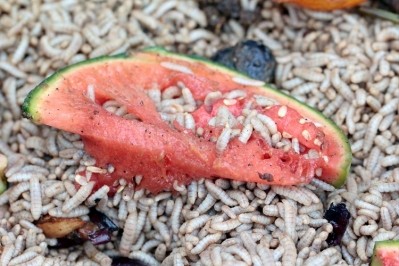Insect-as-food waste a ‘tremendous’ opportunity to boost crop yields sustainably

Insects are slowly wriggling their way into western diets. There are over 1,800 species of edible insects globally, and according to the International Platform for Insects for Food and Feed (IPIFF), around 9m Europeans consumed products with insects in 2019.
Insect consumption is expected to increase, due to their impressive health and sustainability credentials. Insects emit fewer greenhouse gases and less ammonia than cattle or pigs, and require significantly less land and water than cattle, according to the FAO. They are also rich in essential amino acids, with some species providing good quality fatty acids.
The Woven Network expects 390m Europeans will be consuming insects by 2030, and it has been estimated the global insect protein market could be worth up to $8bn at that time, representing 24% annual growth.
According to researchers in the Netherlands, insect farming has other, lesser-known environmental benefits that feed into circular agriculture.
Insect exoskeletons, poop, and unconsumed food
The researchers, all from Wageningen University and Research, describe this development as a ‘novel organic soil amendment’, which is emerging from the production of insects such as yellow mealworm, lesser mealworm, house cricket, black soldier fly, or housefly for food and feed.
A side-stream of insect production is exuviae and frass. The former are the exoskeletons left behind after molting, and frass is ‘basically insect poop and unconsumed food’, explained Wageningen researcher Marcel Dicke.
An important component of insect exuviae is a substance called chitin – a high-molecular-weight amino-sugar polysaccharide present in fungal cell walls and the exoskeleton of many crustaceans. Chitin-containing soil amendments, according to the researchers, have been proven to promote plant growth.
There is a set of bacteria that can metabolise chitin, and those microbes help plants to be more resilient to diseases and pests, said Dicke. “When exuviae are added to soil, the populations of those beneficial bacteria increase.”
Insect frass, too, has been demonstrated to support plant nutrition. Being rich in nitrogen, it is pivotal to plant growth. Both residual streams are considered a potential alternative to conventional fertilisers and pesticides.
Farm to Fork potential
As insect consumption rises, and increasingly used for feed – the EU recently authorised insects as components of pig and poultry feed – large amounts of insect residual streams will become available.
“The application of these residual streams as soil amendments can further contribute to a sustainable and circular agriculture,” noted the researchers.
This is particularly timely in Europe, given the Farm to Fork Strategy’s proposed binding reduction targets for agricultural inputs. By 2030, the strategy calls for a 50% cut in the use and risk of pesticides and a 20% cut in the use of fertilisers.
In ‘light of legislation’, the application of residual streams from insect production as soil amendments can also provide alternatives to support the development of sustainable pest management, the researchers reiterated.
“The use of insect-derived products represents a tremendous opportunity to enhance crop productivity within circular agriculture.”
Moving forward, the Wageningen team suggested studies focusing on the effects of insect-derived products on insect-plant-microbe interactions be expanded, so that strategies for applying these residual streams to control pests, while maximising positive effects on plant traits, can be developed.
Source: Trends in Plant Science
‘Insect frass and exuviae to promote plant growth and health’
Published 2 March 2022
DOI: 10.1016/j.tplants.2022.01.007
Authors: Katherine Y. Barragán-Fonseca, Azkia Nurfikari, Els M. van de Zande, Max Wantulla, Joop J.A. van Loon, Wietse de Boer, Marcel Dicke.
























